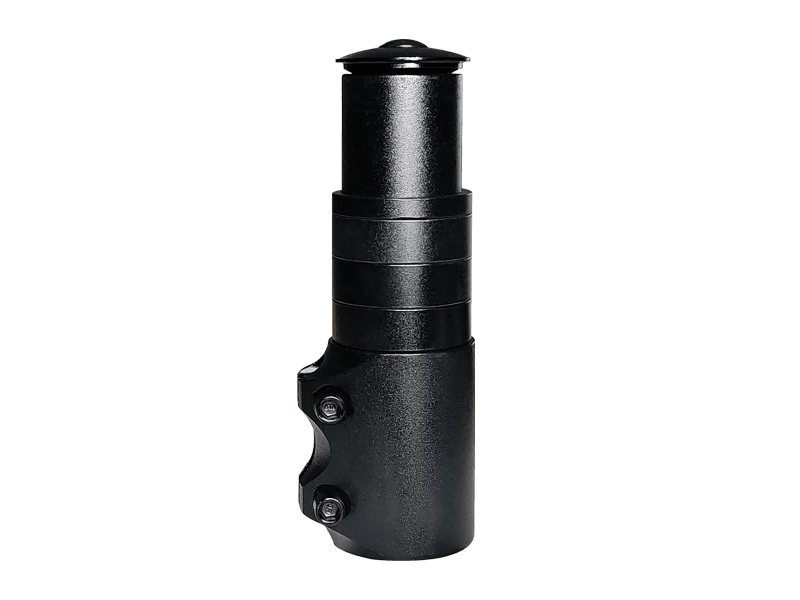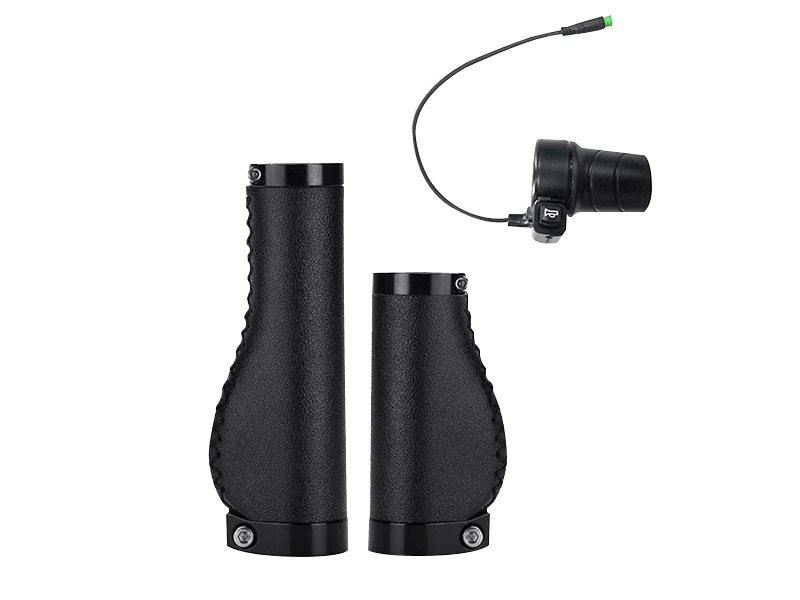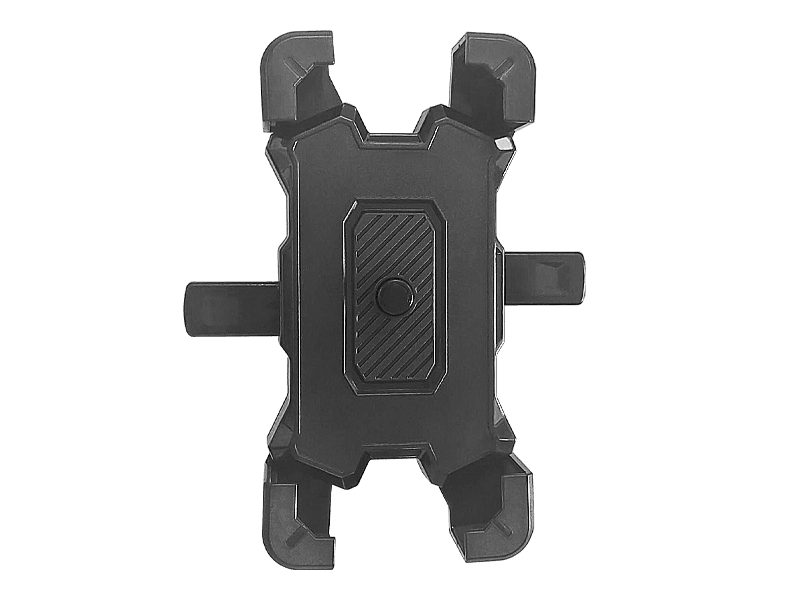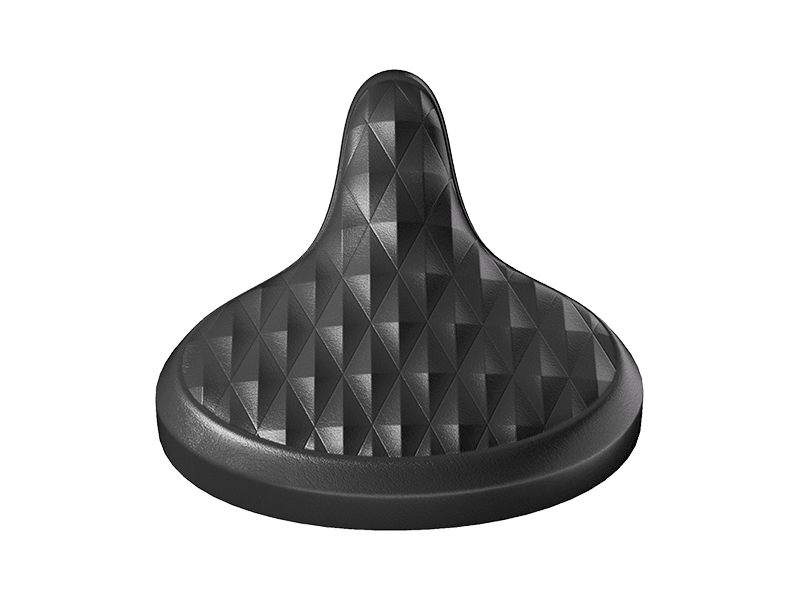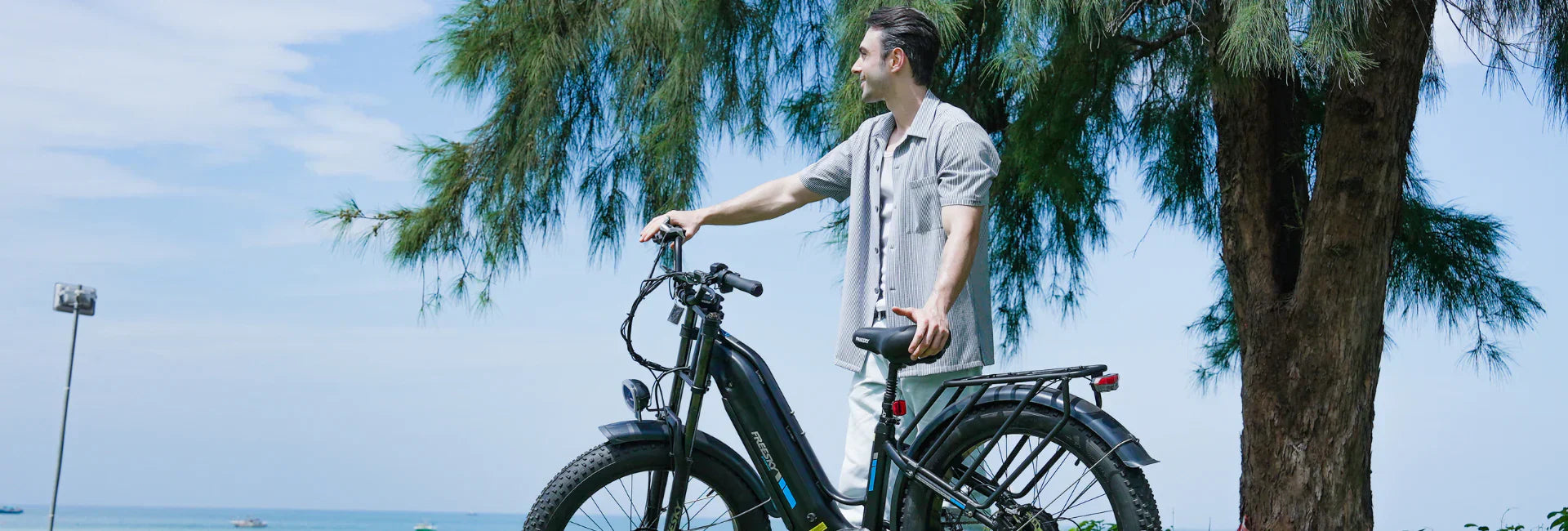Freesky Rocky Pro vs Cyrusher Kommoda 3.0
Aug 29, 2025 09:00
At Freesky, we are dedicated to redefining the electric bike experience through cutting-edge technology and innovative design. Our mission is to deliver an enjoyable, safe, and high-performance ride, which is exemplified by the Freesky Rocky Pro.
With its robust yet sleek design, the Rocky Pro stands as a flagship of versatile e-bike engineering. Featuring advanced components, dual-certified UL batteries, and powerful motor systems, it raises the bar for what a high-end step-through e-bike can offer.
Read on to see how the Rocky Pro excels when compared to one of our most asked-about competitors, the Cyrusher Kommoda 3.0, across performance, comfort, and smart features.
Frame & Usage Scenario
The Freesky Rocky Pro is built for both city commuting and adventure riding. Its step-through aluminum frame paired with a lightweight yet sturdy 6061 alloy design allows for easy mounting, adjustable seating for riders from 5’1” to 5’11”(155~180 cm), and superior overall stability.
In contrast, the Cyrusher Kommoda 3.0 is primarily focused on city commuting, with a slightly heavier frame and a more upright riding posture. Freesky’s design versatility ensures comfort and control in a wider variety of terrains and scenarios.
Weight & Build Material
Both the Freesky Rocky Pro and Cyrusher Kommoda 3.0 are constructed from durable aluminum alloy. The Rocky Pro’s smart frame geometry is designed for optimized handling, providing stability and comfort across various terrains. While the overall weights of the two bikes are comparable, the Rocky Pro’s thoughtful design—including step-through frame and balanced weight distribution—makes it easy to handle and maneuver in urban environments or when lifting the bike for storage.
Power & Motor
The Rocky Pro is equipped with a 750W brushless motor, peak 1200W, offering 100Nm torque and top speeds up to 32 MPH. Combined with its high-performance controller, it conquers 30° slopes with ease.
The Kommoda 3.0, in comparison, has a 250W motor with 85Nm torque and a maximum speed of just 15.5 MPH. Riders seeking higher performance, faster commuting, or hilly terrain will find the Rocky Pro substantially more capable.
Battery & Range
Freesky Rocky Pro features a 48V 25Ah Samsung battery, dual UL-certified for safety and performance, offering 45–90 miles (72-144 km) per charge. Quick charging in 6–8 hours, with a removable design, ensures riders spend more time on the road and less time waiting.
Kommoda 3.0 uses a 48V 20Ah battery with a shorter range of 68 miles (110 km).
Suspension & Comfort
The Rocky Pro incorporates a three-shock absorber system (hydraulic front fork + dual rear spring + shock-absorbing saddle), absorbing up to 85% of bumps and vibrations. It ensures a smooth and stable ride even on uneven terrain.
By comparison, Kommoda 3.0 uses oil-and-spring front suspension and a rear air shock, providing less comprehensive vibration absorption, especially on rough roads.
Brakes & Safety
Freesky employs 4-piston hydraulic brakes with 180mm rotors for precise, stable stopping even at high speeds. The step-through frame, adjustable seat, and robust tire system provide superior control.
Kommoda 3.0 also features hydraulic brakes, but Freesky’s four-piston system gives a clear edge in safety and braking power.
Riding Modes & Control
Freesky Rocky Pro includes 5 riding modes: Electric, Pedal-assist, Cruise, Manual, and Walk, adjustable on the fly to match the rider’s needs. This flexibility ensures optimal control in any scenario.
Kommoda 3.0 also supports multiple modes, but adjustments are more limited and less intuitive.
Tires & Night Riding
With CST 20"x4" fat tires and full lighting systems including turn and brake lights plus an 800-lumen headlight, Rocky Pro is optimized for safety and comfort at night and across all terrains. Kommoda 3.0, while equipped with fat tires, lacks the same level of integrated lighting.
Parameter Comparison Table
Feature
Freesky Rocky Pro
Cyrusher Kommoda 3.0
Advantage
Motor
750W / Peak 1200W Brushless
250W Brushless Rear Hub
Freesky
Top Speed
32 MPH (≈51 km/h)
15.5 MPH (≈25 km/h)
Freesky
Torque
100Nm
85Nm
Freesky
Battery
48V 25Ah Samsung, UL 2271 & 2849
48V 20Ah
Freesky
Range
45–90 miles (≈72–144 km)
68 miles (≈110 km)
Freesky
Charging Time
6–8 hours
6–7 hours
Comparable
Suspension
Front hydraulic + 2x rear spring + seat shock
Oil & Spring front + Air rear
Freesky
Brakes
4-piston hydraulic, 180mm rotors
Hydraulic, 180mm
Freesky
Riding Modes
5 (Electric, PAS, Cruise, Manual, Walk)
PAS with limited modes
Freesky
Tires
CST 20"x4" Fat Tires
Arisun 20"x4" Fat Tires
Comparable
Smart Display
HD LCD + NFC + Type-C Charging
3.7" LCD (requires phone)
Freesky
Adjustable Frame
Step-through, 5’1”–5’11” (155~180 cm)
Step-through, limited
Freesky
Max Load
300 lbs (≈136kg)
350 lbs (≈159kg)
Kommoda (payload)
Warranty
18M motor/battery/controller, 12M others
Similar, battery not dual-certified
Freesky
Conclusion
Freesky Rocky Pro outperforms Cyrusher Kommoda 3.0 in motor power, top speed, battery capacity, suspension, brakes, and riding versatility, while remaining user-friendly and reliable. For riders seeking a high-performance, safe, and technologically advanced e-bike for commuting, leisure, or adventure, Rocky Pro is the clear choice.
Experience the future of riding with Freesky Rocky Pro—where performance, safety, and innovation meet.
Read More
Freesky Ranger vs. Cyrusher Ranger: Powerful Fat Tire E-Bikes Compared
Aug 22, 2025 09:00
When it comes to fat tire e-bikes, riders want a combination of power, range, and safety, all at a fair price. Freesky Ranger and Cyrusher Ranger are both capable fat bikes, but they cater to slightly different needs. Let’s break down how each one performs—and where value meets capability.
Design Philosophy: Dual Power vs. Urban Comfort
Freesky Ranger – Strong, Reliable, and Safe(New Edition)Equipped with dual hub motors delivering 200 Nm torque, Freesky Ranger balances strong acceleration with controllable handling. Its full hydraulic 4-piston disc brakes, fat tires, and robust 6061 aluminum frame ensure short stopping distance and high stability across hills, wet roads, and light off-road paths.
Cyrusher Ranger – Practical and EfficientWith a 250W rear hub motor and torque sensor, Cyrusher Ranger is optimized for city roads, commuting, and light trails. 26"x4" fat tires and hydraulic brakes provide a smooth, predictable ride, but the motor power and range are more modest compared with Freesky Ranger.
Performance Comparison: Power, Torque, and Range
Feature
Freesky Ranger
Cyrusher Ranger
Motor
Dual Hub Motors, 200 Nm torque
250W Rear Hub (95 N·m)
Power
2OOOW Rated, 35OOW Peak
250W
Battery
48V 25Ah, Removable
52V 20Ah LG, Removable
Range
60–95 miles(96-152 km)
74 miles (120 km)
Max Hill Climb
40°
Not disclosed
Brakes
4-Piston Hydraulic Disc
Hydraulic 180mm Front/Rear
Gear System
7-Speed Shimano
9-Speed Shimano
Frame
6061 Aluminum Alloy
6061 Aluminum Alloy
Riding Modes
5 Modes (Cruise, Throttle, Pedal Assist, Regular, Walk Assist)
5 Levels PAS
Why It Matters:
Freesky Ranger: Dual motors and 200 Nm torque provide confident acceleration and controlled climbing. Long-range 48V 25Ah battery allows 60–95 miles(96-152 km) of riding, while 4-piston hydraulic brakes ensure safe stopping on inclines or wet surfaces.
Cyrusher Ranger: Reliable for commuting and light trails, with 250W motor and moderate range. Hill-climbing ability is limited and not officially disclosed.
Ride Experience: Confident Handling vs. Comfortable Commuting
Freesky Ranger – Powerful and Controllable
High-Performance Climbing: Dual motors and strong torque make uphill riding manageable and responsive.
Long-Distance Confidence: Large 25Ah battery extends ride duration for longer journeys.
Safety Focus: Fat tires, full hydraulic brakes, and robust frame design offer stable, controlled riding.
Ideal For: Riders who want strong power, reliable braking, and extended range for both commuting and weekend rides.
Cyrusher Ranger – Urban-Friendly Ride
City Commuting Comfort: Torque sensor and moderate motor support make pedaling easy.
Moderate Terrain: Suitable for paved roads, light trails, and urban exploration.
Ideal For: Riders seeking a comfortable, practical fat bike for everyday use.
Price and Value Consideration
One of the key differences is price. Freesky Ranger is approximately €1100 less expensive than Cyrusher Ranger, offering dual-motor performance, extended range, and 4-piston brakes at a more accessible cost. For riders seeking maximum power and reliable stopping performance without a high premium, Freesky Ranger presents strong value.
Final Verdict: Power and Confidence or Practical Comfort?
✨ Choose Freesky Ranger if you want dual-motor power, high torque, extended range, and safety-focused braking at a competitive price.
✨ Choose Cyrusher Ranger if your rides are mostly urban or light trails, and you value comfort and moderate performance.
“Both bikes offer quality fat tire experiences, but Freesky Ranger gives riders more power, range, and braking reliability for less money, while Cyrusher Ranger emphasizes ease of use and urban practicality.”
Read More
Freesky Alaska Pro vs. Cyrusher Ranger: Which Fat Tire E-Bike Suits Your Adventures?
Aug 15, 2025 09:00
Choosing the right fat tire e-bike isn’t just about specs—it’s about finding a ride that feels safe, reliable, and suited to your typical routes. Freesky Alaska Pro and Cyrusher Ranger each offer strong points, but in different riding scenarios.
Design Philosophy: Safety and Versatility
Freesky Alaska Pro – Powerful and StableAlaska Pro features dual removable batteries, full suspension, and 26"x4" fat tires designed for stability across varied surfaces. The aluminum frame, 4-piston hydraulic disc brakes, and responsive gear system ensure controlled rides on inclines or uneven terrain. Every component is chosen to support confidence and safety, whether you’re commuting, climbing moderate hills, or enjoying extended rides.
Cyrusher Ranger – Comfortable and PracticalRanger prioritizes comfort and ease. Its 250W rear hub motor, 52V 20Ah battery, and torque sensor are optimized for city roads and light trails. Puncture-resistant tires, front suspension, and a reliable brake system ensure smooth, predictable handling in urban or moderately uneven environments.
Feature
Freesky Alaska Pro
Cyrusher Ranger
Motor
1200W Rated, 2500W Peak(130 N·m)
250W Rear Hub (95 N·m)
Battery
48V 41Ah Dual (~1968Wh)
52V 20Ah LG (~1040Wh)
Range
90–160+ miles(144-257 km)
74 miles (120 km)
Max Hill Climb
40°
Not officially disclosed
Suspension
Full Suspension (Lockable Hydraulic Fork + Rear Shock)
Front Suspension Fork w/ Lockout
Brakes
4-Piston Hydraulic Disc
Hydraulic 180mm Front/Rear
Gear System
7-Speed Shimano
9-Speed Shimano
Payload Capacity
300 lbs
350 lbs
Riding Modes
5 Modes + Pedal Assist
5 Levels PAS
Ride Experience: Confidence Over Extremes
Freesky Alaska Pro – Controlled Power and Endurance
Reliable Climbing: 1200W rated / 2500W peak motor provides controlled assistance for hills.
Long-Range Reliability: Dual batteries extend ride distance to 90–160+ miles(144-257 km).
Enhanced Safety: Full suspension plus 4-piston hydraulic brakes offer stable stopping power.
Ideal For: Riders seeking reliable power, long-range rides, and confident braking across a variety of surfaces.
Cyrusher Ranger – Comfortable Urban Riding
Smooth City Commuting: Torque sensor and 250W motor optimize pedaling efficiency.
Moderate Terrain: Suitable for light trails and paved paths, not designed for steep inclines.
Ideal For: Urban riders and casual weekend cyclists who prioritize comfort and predictability.
Key Difference: Reliability vs. Everyday Utility
Freesky Alaska Pro: Focused on strong, controllable power, long-range capability, and safety features to handle varied riding conditions with confidence.
Cyrusher Ranger: Offers urban-friendly comfort, suitable for lighter terrain and moderate distances.
Read More


